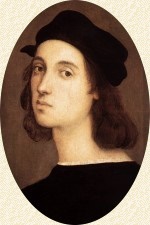|
Raphael (born Raffaello Sanzio) was one of the most famous Italian artists of Renaissance, alongside Leonardo da Vinci and Michelangelo and is regarded as a universal genius like his contemporaries.
Born: 06 April 1483 in Urbino
Died: 06 April 1520 in Rome
Raphael is already trained by his father, Giovanni Sanzio. In the year 1500, he goes to the studio of Pietro Perugino in Perugia, where he it does not take long until his special ability to imitate is noticed. In addition to the great resemblance between Raphael’s the works and those of his teacher, Raphael's early Madonnas are already characterized by a greater agility. So, four years later, he goes to Florence to study the works of Leonardo da Vinci and Michelangelo. Following these artists, half-figured portraits are produced, which are characterized by a great freedom in the attitude of these portraits. Recommended by Bramante, Raphael goes to Rome in 1508. There he works for Pope Julius II on the painting of the papal representative rooms. He colors the Stanza della Segnatura, a work which takes him from 1509 to 1511 and shows the four disciplines: law, philosophy, theology and poetry. Here, Raphael creates a key work of art history through the synthesis of ancient body of thought with Christian religion. Until his death, he elaborates the furnishing of two other papal rooms, as well as the coloring of the Capella Chigi in Santa Maria della Pace and the wall painting "Triumph of Galatea" in the Villa Farnesina. In addition to that he is appointed the construction supervisor of the church of St. Peter in 1514. One of his most famous works, “The Sistine Madonna” also belongs to his late work and shows Mary in the heavenly sphere as a visionary appearance of the beholder.
|
 |
|
|